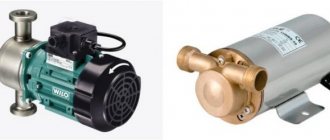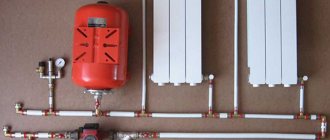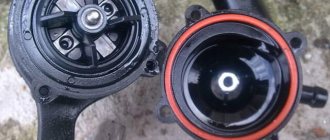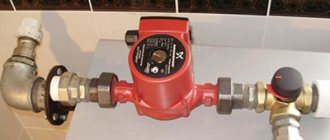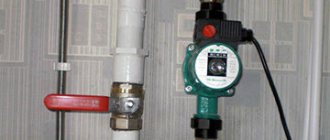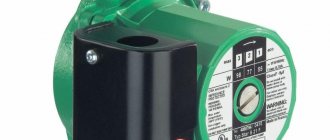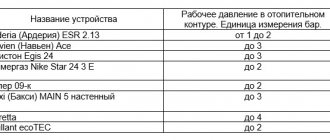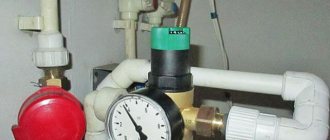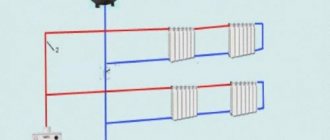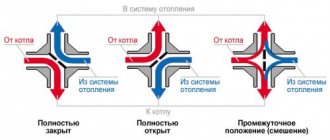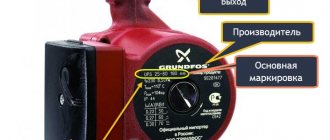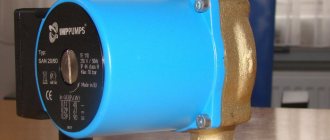Centrifugal pumps: design features in heating systems
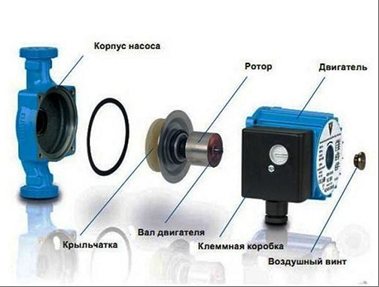
These pumps are integrated into the indoor heating circuit in order to increase its efficiency. When it is turned on together with the operation of the boiler, the temperature in the living rooms rises almost instantly. In addition, convective heat transfer from heating devices improves, since with forced circulation, there are practically no stagnant zones in the network, and the coolant evenly washes all heating surfaces.
The pressure created by the centrifugal device is sufficient for the liquid medium to successfully overcome all existing hydraulic resistances in the network: valves, mud collectors, air vents, batteries, bends and branches and rise to its highest point. For two-story households and above, the installation of a circulation pump in the heat supply system is mandatory. A competently executed installation of the unit reduces the cost of generating thermal energy by up to 20% due to the organization of efficient heat exchange.
An electric pump for circulation of heating water is produced in a housing in which working units and electrical elements are mounted. The main working link of the structure, which rotates the impeller, is the rotor located inside the stator winding.
The housing for such units is made of durable corrosion-resistant materials:
- Aluminum alloys;
- cast iron body, with a pulley;
- stainless steel;
- double or multicomponent brass alloy.
Why is the circulation pump heated, the main reasons and methods for their elimination
There are several options for situations indicating a malfunction of such a device.
Incorrect installation
If the position of the rotor is incorrectly determined and its axis is displaced from the horizontal, there is a possibility of a blowing effect. As a rule, it will be possible to find out about such an erroneous installation of the device immediately after the start of operation of the heating system.
To solve this problem, you will need to correct the position of the rotor.
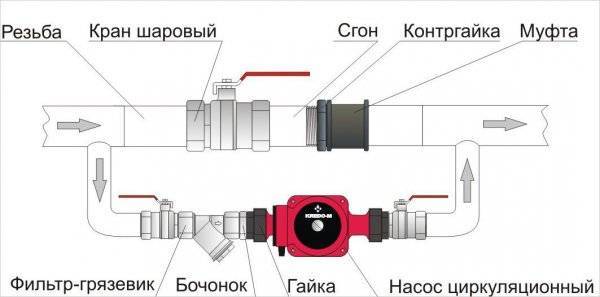

Photo 1. Scheme of installation of a circulation pump in the heating system. To install it, you will need a lot of components.
The device heats up due to a clogged system
The process of circulation of the coolant through the pipes is fraught with the formation of rust in them and the accumulation of deposits. As a result, the pipes are narrowed, and the pumping equipment has to increase its own load to push the liquid. This is how it overheats. Clearing the heating structure will resolve this situation.
Reference. The solution with caustic soda helps, which is used to fill the heating system for 1 hour.
Foreign body
Over time, corrosive particles from old pipes or batteries break off and enter the motor of the circulation device, blocking its operation or provoking the combustion of the windings.
Unscheduled preventive maintenance of the heating system will help, allowing you to get rid of foreign elements, and repair (or replacement) of the pump.
Lack of bearing lubrication
With its deficit, bearings wear in an accelerated mode. Due to their unsuitability for further operation of the device, jamming of its main element - the engine - occurs.
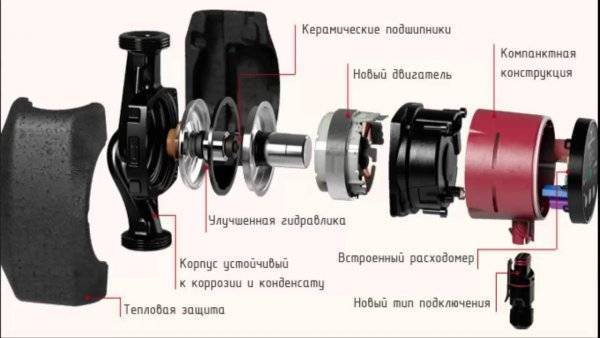

Photo 2. Diagram of the design of a circulating pump with a wet rotor. Arrows indicate the location of all parts, including the bearings.
The heating system device will have to be dismantled and referred to professional diagnostics.
Undervoltage in the network
The indicator of this parameter below 220V provokes rapid airing of the pumping equipment and its failure. Determining the voltage in the network by using a voltmeter will help prevent the problem.
Insufficient head
Overheating causes an illiterate phase connection with a three-phase inclusion of a wheel with blades in the heating circuit. In this case, the direction of its revolutions will be violated. Insufficient head also occurs when the degree of viscosity of the circulating fluid is increased. In this situation, the impeller encounters quite a lot of resistance.
To solve the problem, at the first signs of its manifestation, it is necessary to check the cross-section of the inlet pipe, set the required data for adjusting the pump and eliminate possible deposits on the filter of the inlet pipe.
Stop after start
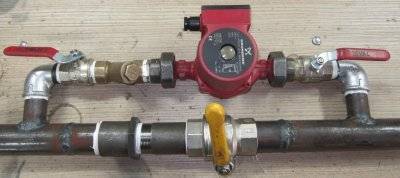

This problem occurs when the phase wires are incorrectly connected in the terminal box. And the fuse of the device is equipped with a loose contact.
To fix the problem, you need to remove it and clean the clamps properly.
The principle of operation of network centrifugal pumps
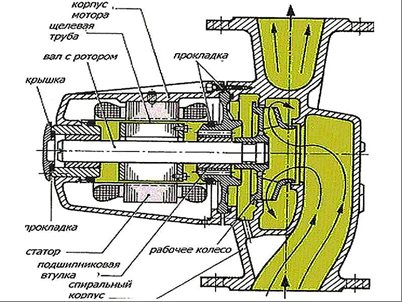

After the power is supplied to the device, the rotor begins to rotate, and with it the impeller, located with it on the same shaft. According to the principle of centrifugal force generated by the impeller, water is drawn from the suction pipe.
At the outlet of the impeller, the coolant enters a spiral-shaped channel in the form of a confuser, in which the kinetic energy received by the liquid from the impeller is transformed into potential energy, thereby increasing the pressure in the heating network.
How circulating pumps work and work
The principle of operation of circulation pumps is not much different from the device of drainage models. The body of the device is made of durable materials that are resistant to corrosion. Usually it is stainless steel, aluminum, brass, cast iron. When started, the engine starts to rotate a rotor equipped with an impeller. As a result, the pressure at the inlet pipe decreases and water is sucked into the hydraulic chamber. The rotation of the impeller creates centrifugal force. Water is pressed against the walls of the chamber and is forcibly thrown into the pipeline through the outlet. This ensures forced circulation of the coolant in a closed heating circuit.
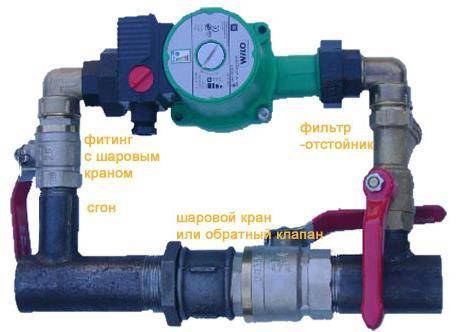

Structural differences in the structure of the rotors of a centrifugal pump for heating
For indoor heat supply systems, two types of devices are used - with a "wet" or "dry" rotor. In the first, it is separated from the pumped liquid by special sealing glands in the form of rings, between which there is a thinnest coolant film. During wear, the sealing parts wear out and at the same time are compressed even more tightly, which guarantees an additional tightness of the block that can withstand the load for a number of years.
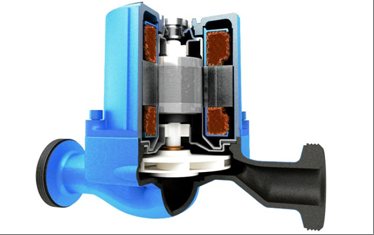

In order for this to be so, such devices require constant maintenance. In the process of pumping liquid, suspended solids that are present in the coolant get between the seal rings, thereby violating the tightness of the entire structure.
The disadvantage of these centrifugal-type devices is their increased noise. Therefore, they are not suitable for indoor use. Due to the fact that they have the highest efficiency and consume less electricity for their own needs, units with a "dry" rotor are more often installed at high thermal heating loads, in a separate building of a boiler house or heat point.
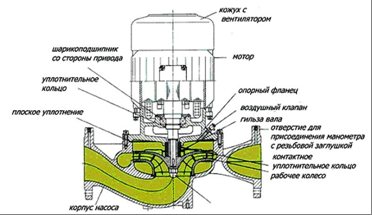

For devices operating with a "wet" modification, the impeller with the rotor is placed in a liquid medium, they are washed by a hot coolant. Electrical assemblies with a starter are housed in a sealed steel glass.During the operation of such a device, the coolant serves as a cooling and lubricating medium for the rubbing parts of the unit, therefore it works almost silently and, therefore, they are preferable for installation in individual houses next to the boiler. Such devices are not whimsical to maintain. And despite the fact that they have low productivity and low efficiency of no more than 50%, these units are more popular with the owners of small cottages. The lifespan of the device depends on the manufacturer of the equipment and usually ranges from 5 to 10 years.
Varieties of pumps
Considering all kinds of options and prices, users pay special attention to the device of the unit. Devices can be roughly divided into two types:
- with a wet rotor.
- with dry inner core.
In the first version, the inner part is separated from the coolant by several O-rings, which increases the tightness of the device. Such a device can operate reliably for two to three years. The pump must be installed in a strictly horizontal position. The unit is lubricated and cooled by moving the liquid by the impeller. It is recommended to install such equipment in a heating system in a house with small diameter pipelines. It is much more difficult to achieve tight connections in pipes of large cross-section.
According to their design features, dry rotor pumps can be modular, cantilever or vertical. To install such equipment, you must call a plumber at home. During operation, all of the listed models emit a lot of noise, their assemblies and parts are sensitive to the quality of the coolant. That is why these devices are recommended to be installed in a separate room.
Note! Dry rotor pumps have a high efficiency (about 80%). Similar equipment with a wet rotor has an efficiency of about 50%.
Heating circulation pump selection parameters
Before choosing such a pump, it is necessary to consider a number of important parameters:
- Productivity is the volume of pumped water per unit of time. This size is determined by the manufacturer of the boiler, since it will depend on how much water will pass through the heating source and the rate of cooling of its internal heating surfaces.
- The maximum permissible temperature of the pumped medium is also a significant indicator, which is indicated in the pump's data sheet, and must correspond to the limiting temperature of the water that the boiler can produce.
- The diameter of the inlet / outlet branch pipes must match the diameter of the boiler piping.
- Head - this characteristic shows to what height the network water can be raised. Usually, for single-storey buildings, up to 20 meters of water column is sufficient, and for multi-storey buildings 60 meters of water column. This indicator should be much higher than the highest mark of the house, since a significant part of the pressure is lost on hydraulic resistances in the network.
- Power is the limiting electrical indicator consumed by the pump for its own needs.
- The presence of safety automation - ensures that the device is turned off in the event of an emergency in the system.
Possible problems and how to fix them
What breakdowns can occur and how to repair the circulation pump with your own hands? Let's figure it out.
The pump hums and the impeller does not rotate
- Foreign object in the impeller chamber.
- Prolonged downtime of the apparatus led to oxidation of the rotor shaft.
- The power supply to the device terminals is interrupted.
In the first case, you can eliminate malfunctions by carefully removing the device and untwisting the housing in the impeller area. If there is a foreign object, remove it and turn the shaft by hand.To avoid re-entry of foreign bodies, a filter should be installed on the nozzle.
The humming of the pump can also be observed during prolonged idle time and shaft oxidation. It is necessary to thoroughly clean all oxidized areas and lubricate the movable parts of the working unit.
The circulating pump hums even if the power supply fails. First check the voltage with a tester. If the cable is damaged or broken, it should be replaced. If the cable is in order, look at the voltage at the terminals. The infinity icon on the tester indicates a short circuit. A lower voltage means a broken winding. In both cases it is necessary to replace the terminals.
The pump does not work at all
The pump does not work when there is no mains voltage. The tester checks the voltage, as well as the correct connection of the device to the power supply.
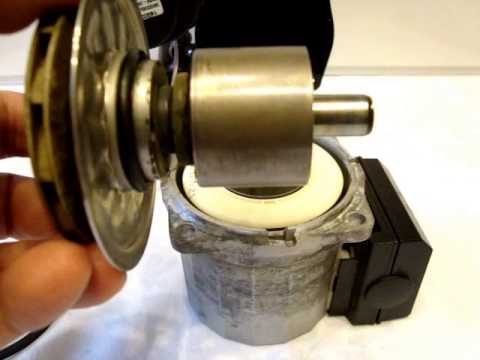

Circulation pump shaft
If there is a fuse in the pump, there is a risk of burnout from power surges. If this happens, replace the fuse. It is advisable to install a reliable stabilizer.
The pump turns on, but stops after a couple of minutes
The reasons may be:
- Limescale between the moving parts of the appliance.
- Incorrect connection of the pump in the area of the terminals.
The pump can turn on, but also stop immediately if there is scale. Remove limescale and lubricate the joints between stator and rotor.
In the second case, check the tightness of the fuse on the device. It is removed and all clamps are cleaned. All wires must be correctly connected in the terminal box.
Pump makes noise when turned on
If the pump is noisy, it may indicate the presence of air in the system. It is necessary to bleed the air from the pipes, mount a unit in the upper part of the circuit so that the air is released automatically.
The pump can also make noise due to wear on the impeller bearing... It is required to disassemble the body of the device, and, if necessary, replace the bearing.
The pump vibrates and makes noise
If the activation of the pump is accompanied by vibration and noise, then the reason is insufficient head in a closed circuit. You can solve it by adding water to the pipes or increasing the pressure at the pump inlet.
Weak pressure
With a low pressure or when the pump almost does not pump the coolant, check the direction of rotation of the impeller in the body of the apparatus. If the impeller rotates incorrectly, then you made a mistake when connecting the pump to the terminals in phases, if you use a three-phase network.
A decrease in head may result from the high viscosity of the coolant. At the same time, the impeller experiences increased resistance and does not work well, not at full strength. It is necessary to check the mesh filter and clean it. It is also advisable to check the cross-section of the pipes of the holes. After that, you will need to adjust the correct parameters of the pump.
The equipment does not turn on
The pump will not turn on if there is a power problem. It is necessary to check the phases and fuses. If they are in order, then the drive winding has burned out. In this case, you will have to seek help from specialists.
Circulation pump installation procedure
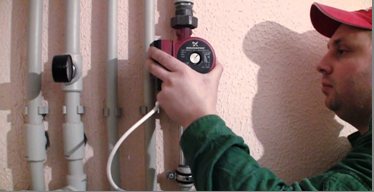

Before connecting the unit, you need to choose the right place for placement. It must be remembered that the device requires periodic maintenance, and therefore there should be enough free space near it. The most optimal area for placing the device is in front of the boiler. Such a scheme will prevent air congestion.
Additional advantages of this option are that the unit will operate with a low-temperature coolant, which will significantly increase its service life. An equally important point in the installation of a centrifugal unit is the location of the working shaft. It must be remembered that the shaft must be placed exactly in a horizontal position.Otherwise, it will not be able to be completely immersed in a liquid medium, which will cause a significant loss of productivity and will contribute to the rapid decommissioning of its working units.
Principle of operation
The principle of operation of heating is as follows - the heating device heats the working fluid, as a rule, it is industrial water or a mixture of water with antifreeze or glycol. These additives reduce the likelihood of freezing of pipes through which the coolant is supplied. After that, the coolant moves through the pipes at a low speed, as it moves, heat is transferred to the heating devices. After returning to the heater, the working fluid is at a fairly low temperature. In this case, the heater operates at the limit of its technical capabilities, which leads to a reduction in its service life.
Installation of a circulation device allows to reduce the hydraulic resistance and thereby ensure the movement of the working fluid through complex and lengthy pipeline complexes.
Its installation will ensure the operation of the heating boiler in a gentle mode and a temperature that is comfortable for living.
The use of this device will make it possible to avoid the need to construct a slope of pipes towards the boiler, to reduce the diameter of the pipes that enter the heating complex. The difference between the temperature at the inlet and outlet of the boiler will be several degrees. This reduces the cost of heating the coolant.
A circulation unit is not a simple engineering equipment, it can fail. In particular, sometimes the circulation pump breaks down due to the fact that it operates at elevated temperatures. Why this can happen, what are the consequences - let's try to understand these issues.
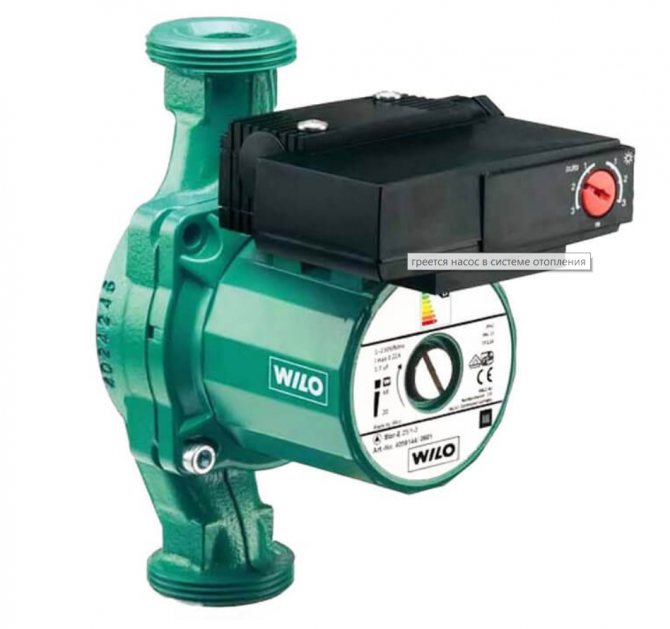

Overheating of the pump casing: the main causes and options for their elimination
In case of detecting a hot body, the consumer must immediately stop the fuel supply to the boiler and stop the electric pump. In order to be able to further cool the internal heating surfaces of the boiler, the bypass or bypass line of the heating network is opened so that the coolant circulates through natural circulation and thereby cools the boiler. Next, the user should try to establish the reasons why the circulation pump of the heating system is heated.
Heating of the pump structural units can occur for the following reasons:
- The installation of the device was carried out in violation of the technology determined by the equipment manufacturer.
- Clogged piping system. Deposits of hardness salts and rust in the inner surface. During many years of operation, they sometimes reach such dimensions that they are able to completely cover the flow area of the pipes. This is especially true in areas with poor circulation. In order to push water through the clogged section, the pump is overloaded, this mode causes the electric motor to overheat.
- The ingress of a foreign body, a similar reason for heating the housing, only the pump is clogged with foreign debris and slag inside.
- Bearings are not lubricated. This failure is typical for dry units.
- Poor quality parameters in the network, less than 220 V.
- Internal causes of electrical failure.
Why is the circulation pump heated?
The pump should be about the same temperature as the pipes. If the pump temperature is higher, then this is already overheating. There are several reasons for the pump to heat up. First of all, it is a clogged system. Lime deposits and rust accumulate on the walls of pipes and radiators, as a result of which the diameter of the pipes narrows, which makes it difficult for the coolant to pass. With slagging of communications, the heat output is insufficient, therefore, the load on the electric motor increases and the circulation pump heats up.
The second reason why the circulation pump is heated is the ingress of a foreign body into it. These can be rust particles that have come off old pipes or radiators. As a result, there is a danger of the motor jamming and, as a consequence, failure of the motor coils (winding burning).
The third reason why the circulation pump gets very hot is the lack of lubrication of the rotary bearings. As a result, accelerated wear of the bearings occurs, which also leads to seizure of the motor and burnout of the windings.
Another reason is the lack of voltage in the network. At reduced voltage, the electric motor operates in extreme mode, therefore, the heating circulation pump heats up.
The reason must be found. If the heating devices and communications are old or have not been flushed for a long time, the system is most likely clogged. It is necessary to clean the system and thus facilitate the passage of the coolant through it, and, if necessary, even replace old pipelines and heating devices. In order not to bring the situation to a critical one, it is necessary to monitor the state of the heating system and flush it regularly. This should be done depending on the duration of use and the temperature of heating the coolant. The higher the temperature of the liquid, the more often the equipment needs to be flushed. For more effective flushing, make a solution with caustic soda and fill the heating system for about 1 hour. The composition perfectly dissolves scale and rust. And the best, of course, is prevention. If you use antifreeze as a working fluid, and not water, then you can significantly increase the service life of the entire system. Water contains dissolved oxygen, which interacts with the metal and leads to corrosion. When using antifreeze, you can not be afraid of corrosion, in addition, this liquid prevents the appearance of scale on the walls of heating devices and pipelines.
To determine why the circulation pump is heating up, periodic measurement of the voltage in the network using a voltmeter will also help. The voltage must be standard, at least 220 V.
If the engine is jammed and the windings are burned out, it is likely that the pump will have to be changed completely. Rewinding of motor windings is a long and expensive process. Easier to replace the pump.
For timely diagnostics, when a pump overheating is detected, you should contact a competent specialist who will check and identify the causes of overheating.
How to disassemble the circulation pump
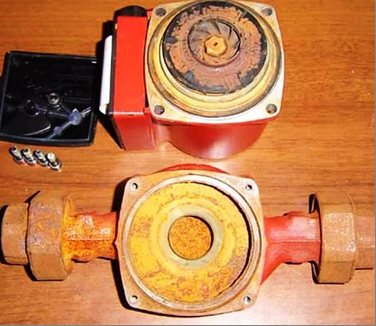

To repair a centrifugal pump installed in the heating circuit, you will need to dismantle it, adhering to the following scheme:
- The electrical part of the apparatus is disconnected from the voltage; for this, the case is removed from the power supply unit.
- Close the valves in the supply and return pipelines or before and after the device, if possible.
- Carry out drainage of the network water so that when the housing is removed from the pipeline, it is not flooded with water.
- In order to unscrew the case, use a hex screwdriver. If the bolts boil during operation, then they are treated with a special WD tool and after 20 minutes, the dismantling operation is repeated.
- After disassembly is complete, remove the cover, under which the rotor with the impeller is located. Usually, it is attached with stoppers or bolts. After that, the passage to the internal structural units of the unit will be opened.
- Having carefully inspected the technical condition of the pump, it will be possible to identify defects and eliminate them.
The principle of operation and the device of circulation pumps
First of all, you need to pay attention to the correct installation of the unit. This device works on the principle of drainage equipment
Its body is made of corrosion-resistant and durable materials. This could be:
- brass;
- stainless steel;
- aluminum alloy;
- cast iron.
The principle of operation of the unit is built as follows. During start-up, the electric motor rotates the rotor with the impeller, which leads to a decrease in the water pressure in the supply pipeline and an increase in centrifugal force. After the coolant passes through the impeller, it enters the polypropylene pipes under pressure. Thus, the uninterrupted movement of liquid in the autonomous heating of a private house is ensured.
Replacing the mains pump repair kit
Most major manufacturers sell ready-made repair kits for the repair of centrifugal units. For example, such a set for a network pump u4814 pumping up 5200 l / h and operating with a voltage of 12/24 V costs 950 rubles. Purchasing a similar kit significantly reduces repair costs. It is possible to carry out repair work on the pump on its own only after the end of the warranty period or the absence of service centers in the area of residence.
Stages of pump repair with the installation of a repair kit:
- Disassemble the pumping part of the device;
- carry out troubleshooting of the internal components of the unit;
- replace rejected parts;
- assembling the unit;
- installed in the workplace and perform post-repair service and performance check.
Why pumping equipment is heated
If the pump heats up in the heating system, this drawback must be eliminated. The temperature of this device should be similar to that in pipes filled with a coolant. When it is higher, then problems arose during operation or errors were made during the installation process.
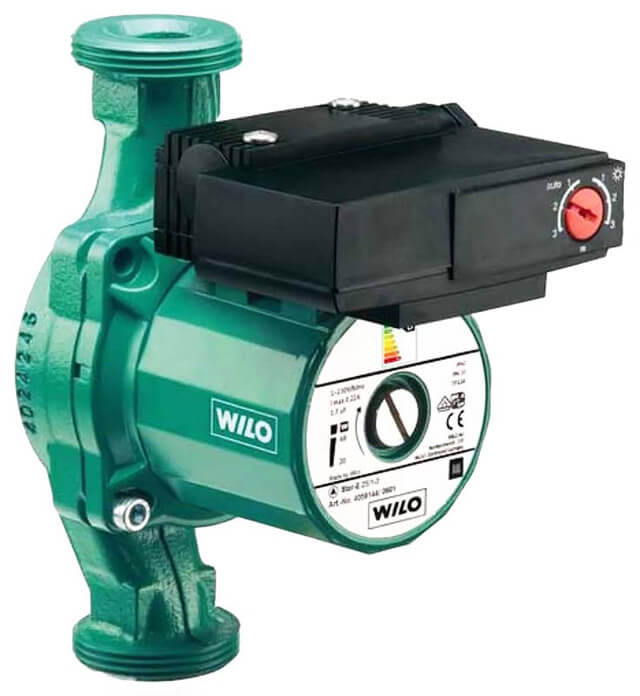

The water pump heats up for a number of reasons:
- Incorrect installation... It is not difficult to find out that mistakes were made during installation - the device begins to overheat at the beginning of the operation of the heat supply structure.
- Clogged system... Over time, deposits and rust build up in the pipes, resulting in a narrower opening for the fluid to pass through. To push water into narrowed pipes, the pump is forced to operate under increased load. As a result, the electric motor overheats. To eliminate the deficiency, unscheduled maintenance of the system elements should be performed.
- Foreign body ingress... Since pipes and batteries are slagged, pieces of plaque and rust are chipped off from their inner surfaces. Once in the pump, they jam the motor. If the device is not cleaned in time, the engine coils will fail.
- Insufficiently lubricated bearings... Since there is not enough lubricant, they wear out much faster, and as a result, the operating time of the device is reduced. In order not to burn out the heating pump, it must be dismantled and sent for repair.
- Undervoltage in the network... When it is less than 220 V, the engine overheats and soon fails. As soon as the first signs of overheating appear, you need to measure the voltage in the network with a voltmeter.
If the heating pump heats up, you should not immediately dismantle it, since the reasons for this are different. First, you need to measure the voltage in the network and, if the values are normal, then rinse the system with caustic soda, filling it with a solution for at least one hour.
When this does not help, you need to contact a specialist, because the pump in the boiler is heating up and may burn out and you will have to buy a new device, since rewinding the motor windings is very expensive.
Heating pump repair video
In the case when the circulation pump of the heating system is heated, you should not immediately disassemble it, for the reason that breakdowns are different. First, you need to measure the voltage in the mains and, if the parameters are normal, then it is necessary to flush the internal circuit of the network. For this, a caustic soda solution is introduced into the circuit for 1 hour. After that, you need to flush the pipelines with clean water. If scale was the cause of the stop, it will go away and the pump should start working.If this action did not bring any result, and the boiler is under warranty, then it is better to contact the service center.
Breakdowns and elimination methods
Depending on the problem, the cause of the breakdown and its elimination are determined:
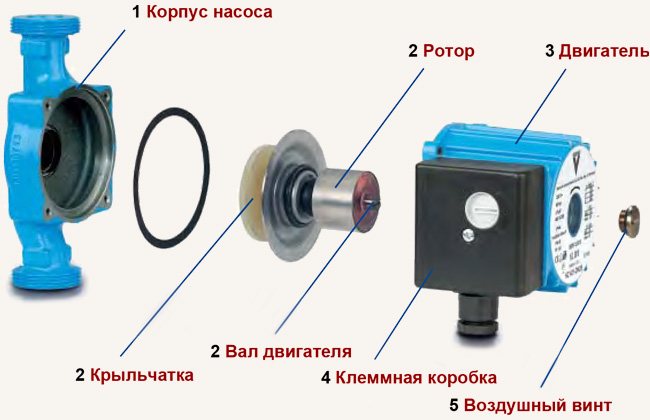

Circulation pump device for heating
- the circulation pump does not turn on and does not make noise. The reason is a burned-out winding or a fuse is out of order. The fuse or winding is changed;
- when the unit is turned on, a hum is heard, but the shaft does not rotate. Why is the unit humming but not working? Most likely, the shaft oxidized during prolonged downtime. If the device is blocked, it is disconnected from the network. The screws connecting the engine and the housing are unscrewed. The motor is removed and the shaft is turned. For low power units, the shaft is unlocked with a screwdriver;
- the pump turns off after it is turned on without starting to work. The reason is limescale between the stator and the rotor. After dismantling the engine, salt deposits are removed;
- during operation, the device starts to warm up. Why is the motor heating up? There are several reasons for heating. Incorrect installation, poorly lubricated bearing, low mains voltage, clogged system. To eliminate the voltage problem, an uninterruptible power supply is installed for the heating pump (UPS). For continuous power supply, protection against power surges, an UPS is used. In the absence of electricity in the network, the UPS will ensure the operation of the unit for fifteen minutes (used as a power source). The UPS will protect the pump motor in the event of a surge, sharp drop or fluctuation in the mains voltage. By connecting the UPS, the heating system will be protected from power surges. Mains power will be safe;
- power problem. The correspondence of the actual voltage in the network with the prescribed in the characteristic is checked;
- the impeller is blocked. To fix the problem, you need to know how to disassemble the device. To eliminate the breakage, the wheel is dismantled and a foreign object is removed. To prevent repeated blocking, a filter is installed at the pump inlet;
- when turned on, the pump may hum. The reason is accumulated air. To fix the problem, you need to bleed the air from the system. Automatic air vents will constantly bleed air. An air vent is needed to release air during operation and start-up of the system;
- the unit vibrates during operation. The reason is bearing wear. Bearing replacement required. The second reason is filter clogging. Washing and cleaning of the filter is required;
- after switching on, the protection of the electric motor is activated. The reason is the electrics of the engine. It is necessary to contact a specialist;
- the water pressure is lower than specified in the technical specifications. We made a mistake while installing the device. It is found in three-phase types of equipment.
DIY heating pump repair (video)
Breakdown prevention
To prevent breakdowns, it is necessary to check the health of the heating pump with your own hands. Before starting the heating season, the unit is checked for breakdowns.
Preventive measures:
- Check for grease. When the pipes dry out, they are lubricated.
- Check if the device is connected to the network correctly. When planning the heating system, a pump is to be placed in front of the boiler. This measure will reduce the formation of air locks to zero.
- The equipment is checked with a tester for correct connection to the network.
- Cleaning the filter from dirt.
- Before starting the heating, the equipment is tested. To pressurize the heating system, water or air is supplied to the system. For crimping, a hydraulic or pneumatic pump is used.
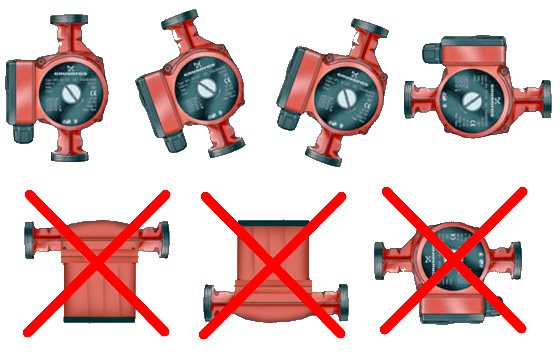

Correct and incorrect installation of the circulation pump
Influence of the pressure testing process on the injection mechanism
The pressure testing process ensures high-quality maintenance of the entire heating system.
In order for the entire system to work without leaks and turn on without problems, this procedure is carried out. The procedure is carried out after disconnecting the system from the network and removing the coolant. Before the procedure, the pipes must be squeezed (cleaned) from scale. Scale deposited on the inner parts of the pipes reduces their permeability by fifty percent, increasing the load on the blower. It will become difficult for the pump to pump water through the system and it will quickly fail. The circulation will be disrupted throughout the system. Heating will not be effective.
If the heating system is not pushed through once every five years, then the centrifugal pump will not cope with its task.
How to properly disassemble the unit?
In case of detection and elimination of malfunctions in the heating system, the equipment must be disassembled. For correct disassembly of the unit, the following rules must be observed:
- The pump is disconnected from the mains. When the pump is inserted into the heating system, a bypass pipe is installed. In operating mode, the pipe is turned off. For repairs, an auxiliary pump is connected. The installation of the pump ensures the further functioning of the heating.
- The valves are unscrewed, the unit is removed.
- The cover of the device is bolted to the body. With prolonged operation, the pump heats up, and the bolts stick to the body, it is impossible to unscrew them. Aerosol "liquid keys" copes with the problem. It is applied to the bolt and can be easily loosened after ten minutes.
- To access the interior, the housing cover is removable. The rotor, wheel and blades are unscrewed.
- Do-it-yourself inspect and repair.
After disassembling the unit, the parts are cleaned and lubricated. Broken ones are being repaired. Those that cannot be repaired are changed.
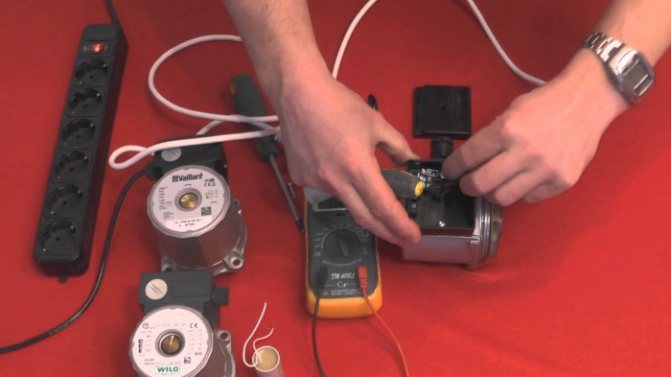

Testing the electrical components of the circulation pump
If the breakdown is related to the wiring, it is better to entrust the repair to the master.
After the repair of the circulation pump for heating is completed, assembly and installation is carried out in compliance with safety measures.
Having studied the design and features of breakdowns, repairing circulation electric pumps for heating with your own hands will not create problems.
Is it necessary, and in what cases
Many owners of suburban real estate, and especially two-story houses, are interested in installing an additional circulation pump in the heating system. They come to this conclusion after uneven heating of the radiators in the premises, provided that the boiler has sufficient power. If the temperature difference between the boiler and the coolant in the pipelines exceeds 20 degrees, then it will be necessary to remove air locks or set the existing pump at an increased speed.
Installation of additional pumping equipment is necessary in the following cases:
- When adding an additional circuit to the heating system, and especially when the pipe length exceeds 80 meters;
- For uniform movement of the coolant in pipelines.
Important! In case of incorrect calculations of the heating system, the installation of additional equipment will lead to a decrease in the efficiency of the heating operation.
An additional pump in the heating system may not be needed if it is balanced using balancing and adjusting valves, so before purchasing additional equipment, bleed the air from the batteries and add water to the system. If everything works fine, then there is no point in installing an additional pump.

